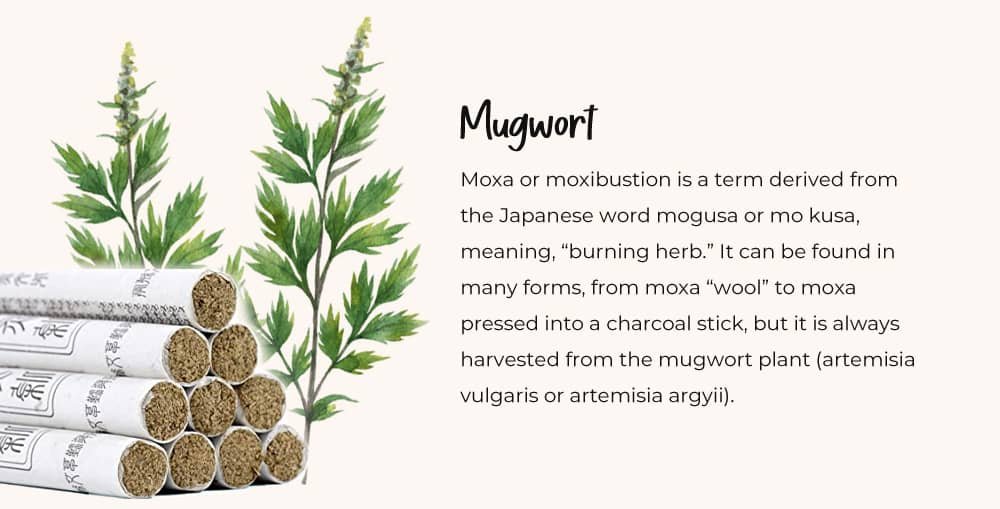What is Moxibustion?
Like Acupuncture, moxibustion is also an important component of Traditional Chinese Medicine with a history of more than 3000 years. It is the process whereby a stick or cone of burning mugwort (Artemesia vulgaris, also called Ai Ye in traditional Chinese medicine) is placed either directly on the skin or indirectly above the skin, over inflamed and affected areas of the body. When lit, moxa sticks burn slowly and provide a penetrating heat that can enter the meridian channels to stimulate the flow of Qi, strengthen the blood flow, therefore releasing therapeutic properties and helping maintain general health.
The flow of Qi can be separated into four different elements: hot, cold, warm, or cool. Moxibustion is an appropriate treatment for people who have a cold ailment. This technique warms up the meridians and rids the body of the cold condition. It is known for its ability to turn breech presentation babies into a normal head-down position that is considered safer during childbirth.
Moxibustion is almost always used in conjunction with acupuncture, as a complementary technique. Patients can be taught how to treat themselves, and moxa sticks are easily purchased.
How does Moxibustion work?
There are various moxibustion techniques:
- Direct Moxibustion:
In direct moxibustion, a small, cone-shaped amount of moxa is placed on top of an acupuncture point and burned. Direct moxibustion is a traditional technique considered to be very therapeutic. A practitioner will either allow the moxa to remain onto the point until it burns out completely (called “scarring” because it produces localized scarring, blisters and scarring after healing) or will extinguish or remove the moxa before it burns the skin (“non-scarring”). Sometimes practitioners place a medium (slice of ginger, topical paste, etc.) between the skin and the burning moxa to prevent possible skin damage. During the direct moxibustion treatment, the patient will feel a pleasant heating sensation that penetrates deep into the skin, but should not experience any pain unless the practitioner is using the scarring method.
- Indirect Moxibustion:
Indirect moxibustion is currently the more popular form because there is a much lower risk of burning. In indirect moxibustion, a practitioner lights one end of a moxa stick (roughly the shape and size of a cigar) and holds it an inch or two away from the skin until the skin becomes slightly red. The intensity of the heat is adjusted according to the patient’s condition and comfort. Indirect moxa is considered to induce a gradual localized vasodilatation response. In addition to increasing local blood flow, skillful indirect moxibustion is extremely comforting and can create a deep relaxation response.
- Needle Moxa Technique:
This technique uses both acupuncture needles and moxa sticks. A needle is inserted into an acupoint and retained. A small stick of mugwort is attached to the tip of the acupuncture needle and ignited. The needle transfers the heat to the acupuncture point and the surrounding area. After the desired effect is achieved, the moxa is extinguished and the needle is removed.
Moxibustion is completely safe, but shouldn’t be used if you have a hot or warm condition. A qualified practitioner will be able to diagnose your condition and classify it so that you’ll receive moxibustion only when you need it. Because moxibustion often includes the burning of mugwort sticks, patients who have respiratory problems should use smokeless moxa sticks instead of smoking moxa sticks. In our clinic, we always use smokeless moxa sticks.
What can be treated with Moxibustion?
In traditional Chinese medicine, moxibustion is used on people who have a cold or stagnant condition. The moxa stick is burned to expel cold and warm up the blood and Qi that are not circulating well.
Moxibustion therapy in conjunction with acupuncture can be very effective for many diseases and conditions including back pain, muscle stiffness, headaches, migraines, tendonitis, arthritis, digestive disorders, anxiety, inflammations and female health problems such as menstrual cramps, irregular periods, and infertility. It is also effective in turning breech presentation babies into a normal head-down position.


